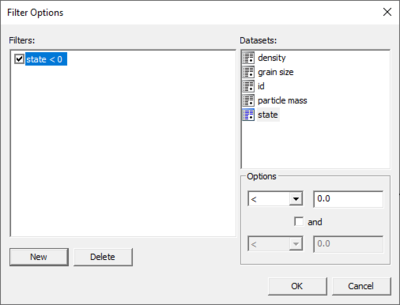SMS:PTM Particle Filters: Difference between revisions
(Created page with "==Particle Filters== The particle filters allow the user to evaluate specific particles based upon different criteria. The filters act exclusively upon particle datasets. Multipl...") |
|||
| (14 intermediate revisions by the same user not shown) | |||
| Line 1: | Line 1: | ||
The particle filters allow evaluating specific particles based upon different criteria. The filters act exclusively upon particle datasets. Multiple filters can be used together to filter multiple datasets. | |||
The particle filters allow | |||
The filters affect: | The filters affect: | ||
| Line 8: | Line 7: | ||
==Dialog Description== | ==Dialog Description== | ||
The following controls are used to define the particle filters. | [[File:PTMparticleFilters.png|thumb|400 px|Example of the PTM ''Filter Options'' dialog.]] | ||
The ''Filter Options'' dialog is brought up by clicking on the '''Filter Options''' command in the ''Data'' menu when the Particle Module is active. The following controls are used to define the particle filters. | |||
===Filters=== | ===Filters=== | ||
Use the New and Delete buttons to create / remove filters. Each filter may be enable / disabled by clicking its toggle box. The filters are defined by selecting a Dataset whose values will be compared against the operands / operators pairs defined in the Options control. | Use the '''New''' and '''Delete''' buttons to create / remove filters. Each filter may be enable / disabled by clicking its toggle box. The filters are defined by selecting a Dataset whose values will be compared against the operands / operators pairs defined in the Options control. | ||
===Datasets=== | ===Datasets=== | ||
| Line 18: | Line 18: | ||
===Options=== | ===Options=== | ||
* Operators – Comparison operators | * Operators – Comparison operators | ||
:{|class="wikitable" | |||
|- | |||
|align="center"| < || Less than | |||
|- | |||
|align="center"| <= || Less than or equal to | |||
|- | |||
|align="center"| equal || Equal to | |||
|- | |||
|align="center"| not equal || Not equal to | |||
|- | |||
|align="center"| > || Greater than | |||
|- | |||
|align="center"| >= || Greater than or equal to | |||
|} | |||
* Operands – Values compared against the selected dataset using the corresponding operators | * Operands – Values compared against the selected dataset using the corresponding operators | ||
* Conjunction – This toggle box disables the second operator / operand pair or performs the and function on them against the first operator / operand pair. | * Conjunction – This toggle box disables the second operator / operand pair or performs the and function on them against the first operator / operand pair. | ||
{{Template:Navbox SMS}} | |||
[[Category:PTM|P]] | |||
Latest revision as of 15:32, 9 October 2017
The particle filters allow evaluating specific particles based upon different criteria. The filters act exclusively upon particle datasets. Multiple filters can be used together to filter multiple datasets.
The filters affect:
- Displayed particles
- Selectable particles (hence selected particle info)
- Compute Grid datasets functionality
Dialog Description
The Filter Options dialog is brought up by clicking on the Filter Options command in the Data menu when the Particle Module is active. The following controls are used to define the particle filters.
Filters
Use the New and Delete buttons to create / remove filters. Each filter may be enable / disabled by clicking its toggle box. The filters are defined by selecting a Dataset whose values will be compared against the operands / operators pairs defined in the Options control.
Datasets
Each filter operates on a single Particle Module dataset. Examples of datasets in the Particle Module include solutions created by the PTM model or using the data calculator.
Options
- Operators – Comparison operators
< Less than <= Less than or equal to equal Equal to not equal Not equal to > Greater than >= Greater than or equal to
- Operands – Values compared against the selected dataset using the corresponding operators
- Conjunction – This toggle box disables the second operator / operand pair or performs the and function on them against the first operator / operand pair.
SMS – Surface-water Modeling System | ||
|---|---|---|
| Modules: | 1D Grid • Cartesian Grid • Curvilinear Grid • GIS • Map • Mesh • Particle • Quadtree • Raster • Scatter • UGrid |  |
| General Models: | 3D Structure • FVCOM • Generic • PTM | |
| Coastal Models: | ADCIRC • BOUSS-2D • CGWAVE • CMS-Flow • CMS-Wave • GenCade • STWAVE • WAM | |
| Riverine/Estuarine Models: | AdH • HEC-RAS • HYDRO AS-2D • RMA2 • RMA4 • SRH-2D • TUFLOW • TUFLOW FV | |
| Aquaveo • SMS Tutorials • SMS Workflows | ||
